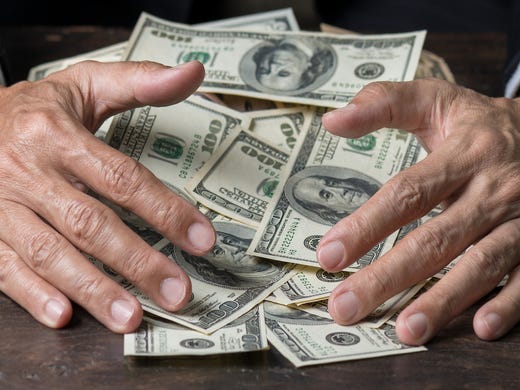Our Ultimate Consuming Culture
"Unlike drugs or alcohol, from which we can be totally abstinent if we want to be, shopping and eating have to be done."
Dr. April Benson, psychologist
"Here's how it works: The initial pleasurable experience -- ooh la la, that bag! -- releases the neurotransmitter dopamine in the nucleus accumbens, a part of the brain that plays a major role in our neural reward circuitry. Each time we do this pleasurable thing, dopamine is released faster, more intensely. The bits of the brain charged with memory encoding record the purchase as a nice experience, thus generating a conditioned emotional response to the cue."
Linda Rodrigues McRobbie, freelance writer, London
"Over time, the pleasure associated with an addictive behaviour subsides, but because the memory of the desired effect and the need to recreate it persists, desire becomes compulsion."
Dr. Carolyn Mair, psychology consultant
"[Corporate interests and marketers exploit our acquisitiveness desires to convince us that specific foods, porn, alcohol are desirable, their language steeped in self-reward.] That's part of the strategy to normalize and make innocuous these things that really aren't."
"Their revenue streams are really dependent on the heavy consumers. Corporations, especially those that market temptation goods, depend on excessive consumption for their bottom line."
Dr. David Courtwright, emeritus professor of history, University of North Florida

"With more materialistic attitudes and more marketing, it's making it harder in general for people to deal with this stuff."
"We have all this media, and yet we're supposed to be able to control our shopping and we're looked down upon if we don't."
Dr. Ricardo Rieppi, psychotherapist

The shopping compulsion: it teases and attracts and compels us to respond to all the advertising we're exposed to on so many levels that have become commonplace and an adjunct to our lives. Everywhere we go, everything we tune into from radio to television, videos and social media make it all so accessible and so interesting, piquing our already-heightened sense of acquisitiveness in a consumer-oriented society. So many items become 'must-haves'. All the more so when they're being flogged by celebrity figures.
Shopping once entailed a physical presence; you deliberately embarked on a mission to go downtown to a shopping area to look about at what was on offer. Now you know what's on offer, advertisements pop up each time you're on line, every time you use your smartphone, everywhere you look while out driving and billboards beckon. And really, it's no longer an effort to shop. In days gone by shopping was carried out in rural areas by the use of mail order items. Now people don't have to haul themselves to shopping centres, the Internet makes it all so simple.
We are indoctrinated and geared through social media influence to want to shop, to acquire the most up-to-date fashions, the latest technological gear, the current home fashions, so readily accessible, all we do is click and it's in the virtual shopping basket and payment is remote, no handing over of cash. In excess of 197 million people buy goods through Amazon monthly. According to Walmart, the largest retailer in the world, $500-billion in sales last year alone beefed up their bottom line. Their top-selling items? laptops, crayons, Instant Pots....really!

In the United States last year, American credit card debt represented a record $870-billion; that's a lot of 'stuff' and it's linked to "compulsive buying disorder"; at least the 19 million Americans who represent the obsessive purchasing segment of the population falling into the category of buying-stuff-they-don't-really-need grouping. German psychiatrist Emil Kraepelin originated the term "oniomania" (buying mania) in 1915 to identify a compulsion he thought of as close to kleptomania.
One survey identified 64 percent of Americans who bought items on impulse later regretted that indiscretion, a condition we call buyer's remorse. So many things that aren't needed, aren't even wanted or particularly liked, but purchased in response to a compulsion to buy items that will later end up being donated to thrift shops, original tags and all. It all began in earnest in the 1980s with the proliferation of malls alongside an increase in disposable incomes. According to experts in the field, compulsive shopping affects a minimum of six percent of the population.
What may be even more surprising is that it isn't only women but men too who tend to compulsion-shop. Researchers point out that shopping helps many people over rough spots in their lives; coasting over depression as a distraction, however temporary. We are tempted by dissatisfaction with life, by feelings of anxiety to elevate our emotions to a more tractable and pleasant position by pleasing ourselves with new acquisitions; a band-aid solution to whatever ails us. It is an addiction that is difficult to regulate and discipline.

Labels: Advertising, Compulsions, Customs, Internet, Shopping, Society

0 Comments:
Post a Comment
<< Home